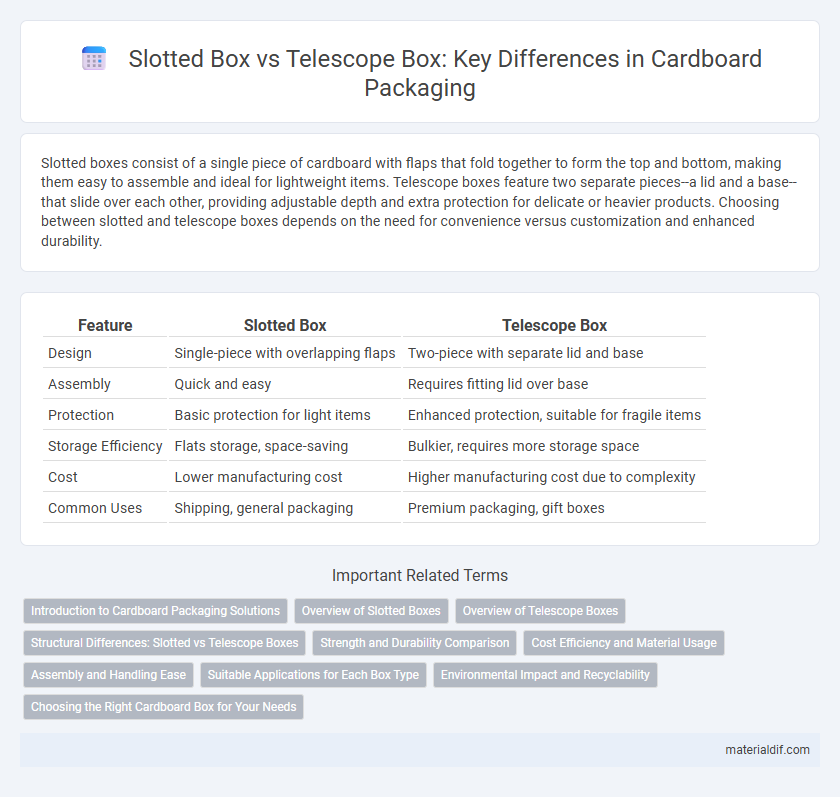Slotted boxes consist of a single piece of cardboard with flaps that fold together to form the top and bottom, making them easy to assemble and ideal for lightweight items. Telescope boxes feature two separate pieces--a lid and a base--that slide over each other, providing adjustable depth and extra protection for delicate or heavier products. Choosing between slotted and telescope boxes depends on the need for convenience versus customization and enhanced durability.
Table of Comparison
| Feature | Slotted Box | Telescope Box |
|---|---|---|
| Design | Single-piece with overlapping flaps | Two-piece with separate lid and base |
| Assembly | Quick and easy | Requires fitting lid over base |
| Protection | Basic protection for light items | Enhanced protection, suitable for fragile items |
| Storage Efficiency | Flats storage, space-saving | Bulkier, requires more storage space |
| Cost | Lower manufacturing cost | Higher manufacturing cost due to complexity |
| Common Uses | Shipping, general packaging | Premium packaging, gift boxes |
Introduction to Cardboard Packaging Solutions
Slotted boxes feature flaps that interlock on the top and bottom, providing cost-effective and easy-to-assemble cardboard packaging ideal for lightweight to medium-weight items. Telescope boxes consist of a separate lid and base that fit over each other, offering adjustable depth and superior protection, making them suitable for fragile or bulky products. Both designs optimize cardboard's durability and recyclability, catering to diverse shipping and storage requirements in packaging solutions.
Overview of Slotted Boxes
Slotted boxes feature a single-piece construction with flaps that fold and meet at the center, providing a straightforward assembly ideal for efficient packing and shipping. Commonly used in e-commerce and retail industries, these boxes offer durability and cost-effectiveness for lightweight to medium-weight products. Their design supports easy customization with printed branding or protective coatings to enhance product presentation and protection.
Overview of Telescope Boxes
Telescope boxes consist of two separate pieces: a lid and a base, which fit over each other to create a secure closure and accommodate products of varying heights. These boxes are commonly used for shipping delicate or bulky items, providing superior structural strength and flexibility compared to slotted boxes. Their design allows for easy assembly and efficient stacking, making them ideal for packaging industries requiring adjustable and protective solutions.
Structural Differences: Slotted vs Telescope Boxes
Slotted boxes feature a one-piece design with four flaps on the top and bottom that interlock when closed, offering simplicity and cost-effectiveness for packaging flat or lightweight items. Telescope boxes consist of two separate pieces, a top and a bottom, that slide over each other, providing adjustable depth and enhanced protection for fragile or variable-sized products. The structural difference lies in the integrated flap mechanism of slotted boxes versus the telescoping overlapping walls of telescope boxes, impacting durability and ease of assembly.
Strength and Durability Comparison
Slotted boxes provide reliable strength through their interlocking flaps, making them ideal for lightweight to moderate loads with efficient stacking capabilities. Telescope boxes offer enhanced durability with their double-layered walls and overlapping top and bottom sections, delivering superior protection for heavier or fragile items during shipping. Choosing between the two depends on the specific requirements for load strength and impact resistance in packaging applications.
Cost Efficiency and Material Usage
Slotted boxes typically offer greater cost efficiency due to simpler manufacturing processes and reduced material waste compared to telescope boxes, which require two separate pieces of cardboard and more complex assembly. The single-piece design of slotted boxes minimizes material usage, lowering production costs for bulk packaging needs. Telescope boxes, while providing adjustable height, often incur higher expenses from increased cardboard consumption and labor-intensive assembly.
Assembly and Handling Ease
Slotted boxes feature simple flaps that fold easily for quick assembly, making them ideal for high-volume packing environments where speed is essential. Telescope boxes consist of two separate parts--a lid and a base--which provide more secure enclosure but require more time and effort to assemble. Handling slotted boxes is straightforward due to their one-piece design, while telescope boxes offer enhanced protection and stacking stability at the cost of slightly increased handling complexity.
Suitable Applications for Each Box Type
Slotted boxes are ideal for packaging products that require easy assembly and secure closure, such as retail goods, electronics, and small appliances. Telescope boxes offer superior protection and adjustable height, making them suitable for fragile items, bulkier products, and shipments requiring layered packaging like furniture or artwork. Choosing between slotted and telescope boxes depends on the need for flexibility, protection level, and product dimensions.
Environmental Impact and Recyclability
Slotted boxes typically use a single piece of corrugated cardboard, reducing material waste and facilitating easier recycling due to uniformity in composition. Telescope boxes, consisting of two separate pieces, may increase material usage and complicate recycling processes, potentially leading to higher environmental impact. Both box types are recyclable, but slotted boxes generally offer a more eco-friendly choice with lower carbon footprint during production and disposal.
Choosing the Right Cardboard Box for Your Needs
Slotted boxes feature flaps that meet in the center and are ideal for lightweight to medium-weight items, offering easy assembly and cost efficiency. Telescope boxes consist of separate top and bottom sections that slide over each other, providing adjustable depth and enhanced protection for fragile or bulky contents. Select slotted boxes for straightforward shipping and storage, while telescope boxes suit applications requiring customizable size and superior cushioning.
Slotted box vs Telescope box Infographic

 materialdif.com
materialdif.com